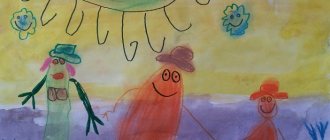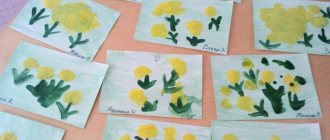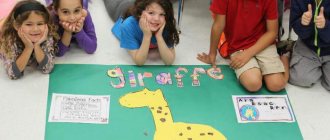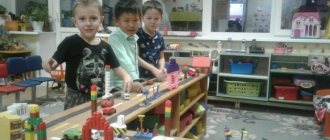Drawing "It's Raining"
The older group is already identifying the characteristics of rain (mushroom, blind, torrential, autumn, summer). The teacher just needs to focus on the fact that the drops are depicted in one direction. First, children draw clouds with raindrops, then they depict people with an umbrella; at the last stage, preschoolers depict rain “on the other side of the window.”
What to pay attention to when depicting rain clouds.
- If the clouds are nearby, then depict the rain as elongated drops of different sizes, but in the same direction. The drops start from the middle of the cloud, and not from the edge. The bottom and top of the clouds are darker in color than the foreground.
- If the clouds are far away, then shade the background under them with a pencil, forming a continuous shower stream. Then use strokes to identify individual raindrops.
This is a simple drawing (“It’s Raining”). The older group is quite capable of depicting “natural” weather phenomena. The following rules will help with this.
- You always depict rain on a dark background, regardless of whether you draw with paints, pencils, pastels, or oils.
- Draw the rain lines parallel to each other.
- You convey bright drops through the pressure of an eraser, a candle, different colors or a special bristled fan brush.
If you need to depict rain as a natural phenomenon, then draw a landscape, and after some time apply drops of light paint on top of it with continuous inclined strokes. If you make drops with an eraser, first draw directions with the wide side, and then with a sharp corner, using strong pressure, create a highlight of the drops.
You depict people in the pouring rain in a similar way. But attention is paid not only to the direction of the rain, the shape of the drops, but also to puddles and the force of the splashes. This is taught to preschoolers in individual drawing lessons.
Drawing autumn
October is the month of autumn competitions. The teacher needs to consolidate the weather properties with the children through drawing (“Autumn”). The older group compares all the autumn months, finds similarities and differences, and remembers color transitions. The simplest task is when children depict a lonely tree. To do this, first determine its location and mark the trunk and branches with a “slingshot”.
Then small ticks are also schematically applied on the branches. Using paint, the thickness of the trunk and branches is “increased”. On top of the branches, foliage is depicted in different colors (red, orange, yellow). Now all that remains is to draw the lawn, sky, clouds, sun and shadow from the tree.
Autumn can be depicted by drawing leaf fall. Here children consolidate their knowledge about trees. The easiest option is to depict autumn with prints (this method is most preferred by the older group).
Drawing: theme "Autumn"
You can draw tree trunks with branches, and put leaf dots with your fingers. Preschoolers of any age also enjoy this. For the competition, many children, showing their imagination, draw an image of autumn with a woman’s face and leaves instead of hair. This consolidates knowledge about the proportions of the human face, leaves, trees and the color scheme of autumn.
Card file “Games for the artistic and creative development of children” (senior preschool age)
"PICK UP A WORD"
Goal: develop the ability to select the right words for a picture Material: reproduction of a painting. Game description: It often happens that you really like a picture, but it’s difficult to talk about it, it’s difficult to find the right words.
The teacher names 2-3 words, and the children choose one of them that is most suitable for this picture, and explain their choice. For example, I. Mashkov’s painting “Moscow Food. Breads” Sonorous – sonorous – quiet Sonorous. There are very bright, sonorous colors here.
Their voice is not ringing, although loud. Rather, it is thick, like the aroma of all these breads. Spacious - cramped Tight. There are so many things depicted here.
Of course, they are cramped. Joyful - sad Joyful. There is abundance here! And all this food is so beautiful, elegant, as if at a holiday, as if the rolls and breads were showing off to each other, which one is better. Light - heavy Heavy. There's a lot here. The breads are large and heavy. And all around are lush buns and pies. Everything together looks like something dense and heavy. How soon does the table hold up?
“FIND PICTURES PAINTED WITH WARM AND
COLD PAINTS"
Goal: to consolidate children’s ideas about warm and cold colors. Material: reproductions of still lifes, painted in warm and cold colors. Game description: Find paintings painted only in warm colors (or cold ones) or sort paintings painted in warm and cold colors into groups.
“DEFINE AND FIND THE GENRE OF PORTRAIT (STILL LIFE, LANDSCAPE)”
Goal: to clarify children’s ideas about different genres of painting: landscape, portrait, still life. Material: reproductions of paintings. Game description: 1 option. The teacher suggests looking carefully at the paintings and putting paintings depicting only a still life (or only a portrait, landscape) in the center of the table, putting others aside. Option 2. Each child has a reproduction of a painting, some of them depict a landscape, some have a portrait or a still life. The teacher asks riddles, and the children must show the answers using reproductions of paintings.
If you see in the picture a river is drawn, Or a spruce and white frost, Or a garden and clouds, Or a snowy plain, Or a field and a hut, The picture must be called... (landscape)
If you see in the picture a Cup of coffee on the table, Or a fruit drink in a large decanter, Or a rose in crystal, Or a bronze vase, Or a pear, or a cake, Or all the objects at once, Know that it is... (still life)
If you see someone looking at us from a painting - Or a prince in an old cloak, Or a steeplejack in a robe, A pilot, or a ballerina, Or Kolka, your neighbor, The painting is definitely called... (portrait).
“MAKE A STILL LIFE”
Goal: to consolidate knowledge about the genre of still life, to teach how to compose a composition according to your own plans, according to a given plot (festive,
with fruits and flowers, with dishes and vegetables, etc.) Material: various pictures depicting flowers, dishes, vegetables, fruits, berries, mushrooms or real objects (dishes, fabrics, flowers,
dummies of fruits, vegetables, decorative items)
Description of the game: the teacher invites children to create a composition from the proposed pictures, or to create a composition on the table from real
objects using various fabrics for the background.
"FIND THE ERROR"
Goal: to teach children to listen and watch carefully, to detect and correct mistakes. Material: reproductions of paintings. Description of the game: the teacher, in an art history story, describes the content of the work and the means of expression used by the artist, explains what mood the artist wanted to convey in his work, but at the same time deliberately makes a mistake in describing the picture. Before starting the game, children are given the instruction to watch and listen carefully, as a mistake will be made in the story. Rules. Listen and watch carefully, detect and correct errors. The winner is the one who identified the most errors and corrected them correctly.
He also gets the right to be the leader in the game - to compose an art history story based on another work. An approximate art history story by a teacher (with intentional errors) based on the painting “Haymaking” by A.A. Plastova: “Before you is a reproduction of a painting by A.A. Plastov “Summer” (wrong in the title). She talks about how, on a hot, clear day, in a meadow covered with green, emerald grass (there is no description of flowers),
mowers came out - old men and women (the image of a teenager is missing from the description). The most important and beautiful thing in this picture are the white-trunked birches; they are painted in the center of the picture (an erroneous description of the compositional center). The work conveys peace and quiet joy.
To do this, the artist uses bright, rich colors: yellow, green, blue, red.”
"LIVING PICTURE"
Goal: to develop empathy in children by endowing objects with human feelings, thoughts, and characters. Material: reproduction of a painting. Description of the game: children are divided into groups. Each group receives a reproduction of a painting by an artist. Children should, on behalf of those depicted in the picture (roads, trees, sky, etc.) talk about their colors and their mood, without naming it. The task of everyone else is to guess what is depicted in this or that picture and its name.
"MAGIC COLORS"
Goal: during the game, to develop children’s attention and interest in various colors and shades, a feeling of joy when perceiving the beauty of nature. Material: cards with different colors. Game description: give children cards with squares of different colors. Then the teacher says a word, for example: birch. Those of the children who have
black, white and green squares, raise them up. Then the teacher says the next word, for example: rainbow, and the squares are raised by those children whose colors correspond to the colors of the rainbow. The children’s task is to respond as quickly as possible to the words spoken by the teacher.
"PARTS OF THE DAY"
Goal: Determine which part of the day (morning, afternoon, evening, night) the proposed landscapes belong to, choose a color card with which this or that part of the day is associated. Material: Reproductions of paintings with landscapes that clearly express the parts of the day. Game description: create play situations with toys that reflect their behavior at different times of the day. Consider various reproductions of paintings, determining what time of day the artist depicted. Justify
your choice with a short descriptive story, emphasizing the meaning of color in the work. You can use literary texts in the game
about parts of the day:
Morning. The spring forest keeps a secret, What he saw at dawn, Like a lily of the valley holding dew suspended in glass cups.
Day. Worked all day - Handed over a lot of tasks; And in the evening I regretted that there was nothing to do.
Evening. The train is knocking in the distance, a fish splashed in the pink river, the sun sat down behind the silent forest... The day became a little sad and disappeared.
Night. There are plenty of stars - both in the sky and in the water. On earth - not a light anywhere. The animals and insects went to bed. Silence from heaven to earth.
"FIND OUT BY PROFILE"
Goal: identify characters by silhouette profile. Name the signs by which the character was recognized and identified. Material: profile silhouettes of characters from various fairy tales. Description of the game: the teacher shows the children a portrait of a fairy-tale character, the children try to find out who is depicted on it based on certain signs.
"FAMILY PORTRAIT"
Goal: to consolidate children’s knowledge about the gender and age characteristics of people. Material: 6 portraits, cut into 4 parts (forehead, eyes, nose, lips and chin), separate wigs and false parts (mustaches, beards, glasses). Description of the game: from the cut parts you will make portraits: mothers, fathers, grandmothers, grandfathers, sisters and brothers. And name the distinctive features of a male and female face, young and old.
"SEASONS"
Goal: to consolidate children’s knowledge about seasonal changes in nature, about the color scheme inherent in a particular time of year. Material: Reproductions of paintings with landscapes, audio recording of P.I. Tchaikovsky “Seasons” Description of the game: different reproductions of paintings are hung on the wall, the teacher invites the children to select those that tell about one season. You can use in the game an audio recording of P.I. Tchaikovsky “The Seasons” and artistic texts about the seasons: Four artists, the same number of paintings. I painted everything with white paint. The forest and field are white, white meadows. Snow-covered aspens have branches like horns... The second one has blue skies and streams. A flock of sparrows splash in blue puddles. There are transparent pieces of ice-lace on the snow. The first thawed patches, the first grass. In the third painting there are countless colors: Yellow, green, blue... There is a green forest and field, a blue river, White, fluffy clouds in the sky. And the fourth painted the gardens with gold, productive fields, ripe fruits... Everywhere beads and berries ripen in the forests. Who are those artists? Guess yourself!
It's a sad time! Ouch charm! Your farewell beauty is pleasant to me - I love the lush decay of nature, the forests dressed in crimson and gold... (A.S. Pushkin)
White, fluffy snow swirls in the air, and quietly falls to the ground and lies down. And in the morning the Field turned white with snow, as if everything had covered it with a shroud. The dark forest covered itself with a wonderful hat and fell asleep under it, soundly, soundly... God's days are short, the sun shines little, now the frosts have come and winter has come. (I. Surikov “Winter”)
“WHAT HAPPENED, WHAT WILL HAPPEN?”
Goal: to teach children to imagine the past and future of an object and compose a coherent story about it. Material: reproduction of a painting. Description of the game: the presenter selects an object, invites the players to take a ride on the Time Machine and talk about what happened to him in
the past and what may happen in the future.
“EXPLAIN WHY THE PICTURE IS NAMED SO”
Goal: to develop children’s mental actions leading to an explanation of the meaning of what is depicted in the picture. Material: reproduction of a painting. Description of the game: the teacher prepares pieces of paper on which proverbs and sayings on various topics are written. The rule is introduced:
pull out the note, read the text (read by the teacher or children who can read), explain why the picture is named that way.
DIDACTIC EXERCISES:
“What can this be compared to?”
“Who can name more words that characterize a person’s mood?”
“Who can name the most words starting with the sound “s”?”
“Tell me without words, with facial expressions and gestures, what you would paint a picture about”
“Choose beautiful words for the word...”
“Complete the sentences: If the grass were blue, then... If the snow was black... If the sea was red...”
“The Queen of the Earth is having a ball. The color fairies brought the best gifts of their colors to the ball. What gift did the black fairy bring?”
“What color is the voice of mom (dad, baby, etc.) when she laughs, sings or cries...?”



